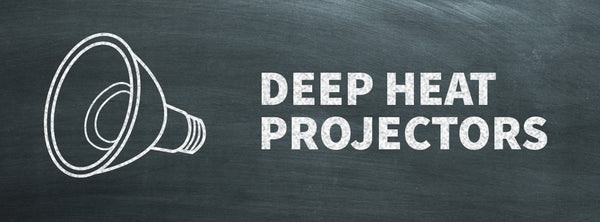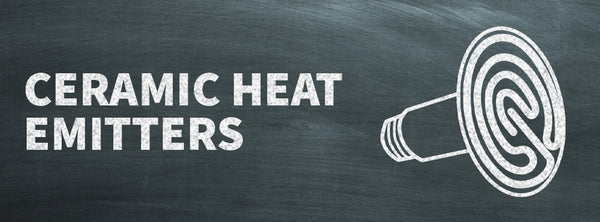Your Cart is Empty
Menu
-
- Live Animals
- Nutrition
- Habitats
- Habitat Supplies
- Light & Heat
- Humidity
- Husbandry
- Merch
-
- Contact Us
- Info
- Blog
- Professionals Login
- Gift Cards
- Login

0
Your Cart is Empty

Your Cart is Empty
April 09, 2024 3 min read
On the surface, deep heat projectors(DHPs) and ceramic heat emitters (CHEs) seem like very similar products. Both solutions slot into a standard lightbulb socket and emit heat with little to no visible light. However, each of these solutions have strengths and weaknesses and are better suited for different purposes. Let’s talk about what each of these heat elements are good for, and build a framework so that you know which to get for your reptile’s enclosure!
You can also watch our video on the topic here!
First, let’s go over things that both DHPs and CHEs have in common!
Both heating solutions are dimmable and can be controlled by dimming thermostats. Whether you choose a DHP, CHE, or both, they should be on dimmable thermostats or rheostats to avoid overheating your reptile.
Both options emit little to no visible light. Deep heat projectors do emit a small amount of visible red light from their glowing filament, but this amount is negligible. This means both heaters can be used through the night if needed!
Both heaters are widely available at many retailers including Pangea! Once you’ve made your decision, you can easily order your deep heat projector or ceramic heat emitter as well as any other supplies you may need!

Deep heat projectors are great solutions for creating a basking spot for your reptile. They are found in a range of wattages from 50W all the way up to 150W. They differ from ceramic heat emitters by projecting infrared-A and B which are fantastic at penetrating the outer layers of skin, delivering heat deeply into your reptile’s tissue (hence deep heat). You can feel this effect yourself when holding your hand under a DHP, or standing in the sun; it’s the sort of heat that feels somewhat tingly to us.
Deep heat projectors can also raise ambient temperatures to a degree when heat radiates off objects in the enclosure, however, ceramic heat emitters are better at raising ambient temps.
The largest downside to deep heat projectors is their cost. While they’re efficient and long-lasting, your up-front cost will be higher than many other heating elements.

In contrast to deep heat projectors, ceramic heat emitters are best used for raising ambient temperatures in your enclosures. Ceramic heat emitters emit infrared-C which doesn’t penetrate very well into the tissue of your reptile but instead radiates into the air, raising the overall temperature around it. While these wouldn’t be the best option for a basking spot requiring concentrated heat, they are fantastic for maintaining a baseline temperature in the enclosure and establishing a heat gradient.
The downside of this radiant heat is how it affects humidity. Many keepers have reported that CHEs can quickly dry out an enclosure. This can of course be mitigated by regular misting, either by handor with an automated system.
Ceramic Heat Emitters are found at many common wattages, including 50, 60, 80, 100, and 150W. In addition to this range though, smaller, Nano-sized Ceramic Heat Emitters exist which are great for enclosures that only need a bit of extra warmth.
Well, that depends on your reptile’s needs. A deep heat projector is a great choice if your reptile has a high heat requirement and needs a strong basking spot. If you need to maintain temperatures overnight or want to regulate temperatures without affecting light levels, a ceramic heat emitter is a great choice.
The key thing to consider is that both heat elements are tools that can be used together or individually in lighting and heat arrays. Does your reptile need a basking spot? Consider adding a DHP for the deep tissue heating! How does your temperature gradient look, do you need extra heat for your warm side? Add a CHE to your array to boost those temps!
The question changes from “Which is better, DHPs or CHEs?” to “Which of these tools is right for the task at hand?” Choose the heating element that fulfills the unanswered needs of your reptile, and continue to monitor temperatures and adjust your solutions accordingly!